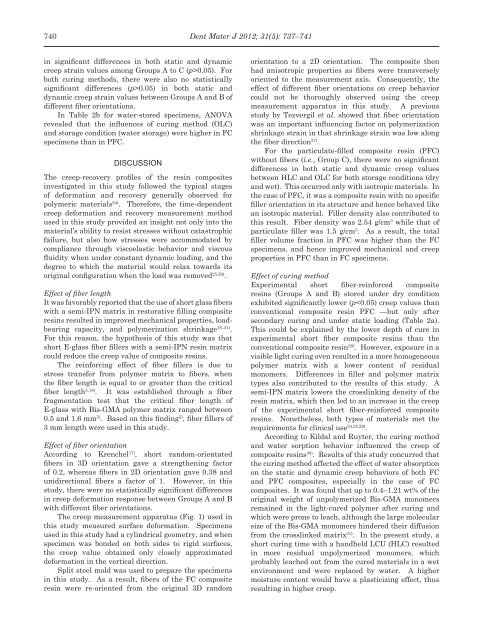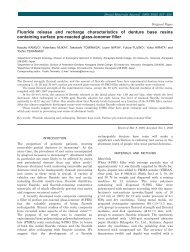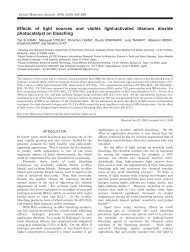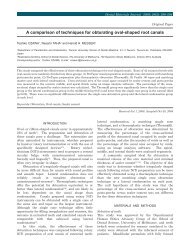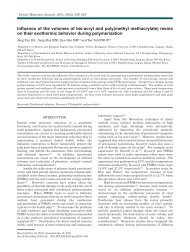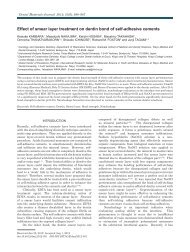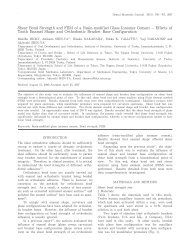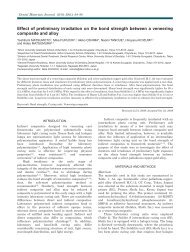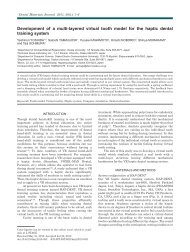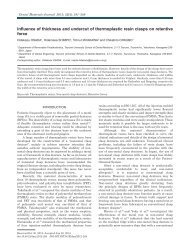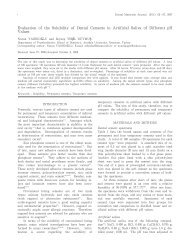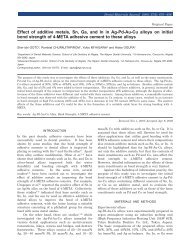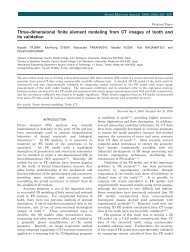Creep of experimental short fiber-reinforced composite resin
Creep of experimental short fiber-reinforced composite resin
Creep of experimental short fiber-reinforced composite resin
You also want an ePaper? Increase the reach of your titles
YUMPU automatically turns print PDFs into web optimized ePapers that Google loves.
740 Dent Mater J 2012; 31(5): 737–741<br />
in significant differences in both static and dynamic<br />
creep strain values among Groups A to C (p>0.05). For<br />
both curing methods, there were also no statistically<br />
significant differences (p>0.05) in both static and<br />
dynamic creep strain values between Groups A and B <strong>of</strong><br />
different <strong>fiber</strong> orientations.<br />
In Table 2b for water-stored specimens, ANOVA<br />
revealed that the influences <strong>of</strong> curing method (OLC)<br />
and storage condition (water storage) were higher in FC<br />
specimens than in PFC.<br />
DISCUSSION<br />
The creep-recovery pr<strong>of</strong>iles <strong>of</strong> the <strong>resin</strong> <strong>composite</strong>s<br />
investigated in this study followed the typical stages<br />
<strong>of</strong> deformation and recovery generally observed for<br />
polymeric materials 24) . Therefore, the time-dependent<br />
creep deformation and recovery measurement method<br />
used in this study provided an insight not only into the<br />
material’s ability to resist stresses without catastrophic<br />
failure, but also how stresses were accommodated by<br />
compliance through viscoelastic behavior and viscous<br />
fluidity when under constant dynamic loading, and the<br />
degree to which the material would relax towards its<br />
original configuration when the load was removed 25,26) .<br />
Effect <strong>of</strong> <strong>fiber</strong> length<br />
It was favorably reported that the use <strong>of</strong> <strong>short</strong> glass <strong>fiber</strong>s<br />
with a semi-IPN matrix in restorative filling <strong>composite</strong><br />
<strong>resin</strong>s resulted in improved mechanical properties, loadbearing<br />
capacity, and polymerization shrinkage 18–21) .<br />
For this reason, the hypothesis <strong>of</strong> this study was that<br />
<strong>short</strong> E-glass <strong>fiber</strong> fillers with a semi-IPN <strong>resin</strong> matrix<br />
could reduce the creep value <strong>of</strong> <strong>composite</strong> <strong>resin</strong>s.<br />
The reinforcing effect <strong>of</strong> <strong>fiber</strong> fillers is due to<br />
stress transfer from polymer matrix to <strong>fiber</strong>s, when<br />
the <strong>fiber</strong> length is equal to or greater than the critical<br />
<strong>fiber</strong> length 5,18) . It was established through a <strong>fiber</strong><br />
fragmentation test that the critical <strong>fiber</strong> length <strong>of</strong><br />
E-glass with Bis-GMA polymer matrix ranged between<br />
0.5 and 1.6 mm 5) . Based on this finding 5) , <strong>fiber</strong> fillers <strong>of</strong><br />
3 mm length were used in this study.<br />
Effect <strong>of</strong> <strong>fiber</strong> orientation<br />
According to Krenchel 17) , <strong>short</strong> random-orientated<br />
<strong>fiber</strong>s in 3D orientation gave a strengthening factor<br />
<strong>of</strong> 0.2, whereas <strong>fiber</strong>s in 2D orientation gave 0.38 and<br />
unidirectional <strong>fiber</strong>s a factor <strong>of</strong> 1. However, in this<br />
study, there were no statistically significant differences<br />
in creep deformation response between Groups A and B<br />
with different <strong>fiber</strong> orientations.<br />
The creep measurement apparatus (Fig. 1) used in<br />
this study measured surface deformation. Specimens<br />
used in this study had a cylindrical geometry, and when<br />
specimen was bonded on both sides to rigid surfaces,<br />
the creep value obtained only closely approximated<br />
deformation in the vertical direction.<br />
Split steel mold was used to prepare the specimens<br />
in this study. As a result, <strong>fiber</strong>s <strong>of</strong> the FC <strong>composite</strong><br />
<strong>resin</strong> were re-oriented from the original 3D random<br />
orientation to a 2D orientation. The <strong>composite</strong> then<br />
had anisotropic properties as <strong>fiber</strong>s were transversely<br />
oriented to the measurement axis. Consequently, the<br />
effect <strong>of</strong> different <strong>fiber</strong> orientations on creep behavior<br />
could not be thoroughly observed using the creep<br />
measurement apparatus in this study. A previous<br />
study by Tezvergil et al. showed that <strong>fiber</strong> orientation<br />
was an important influencing factor on polymerization<br />
shrinkage strain in that shrinkage strain was low along<br />
the <strong>fiber</strong> direction 27) .<br />
For the particulate-filled <strong>composite</strong> <strong>resin</strong> (PFC)<br />
without <strong>fiber</strong>s (i.e., Group C), there were no significant<br />
differences in both static and dynamic creep values<br />
between HLC and OLC for both storage conditions (dry<br />
and wet). This occurred only with isotropic materials. In<br />
the case <strong>of</strong> PFC, it was a <strong>composite</strong> <strong>resin</strong> with no specific<br />
filler orientation in its structure and hence behaved like<br />
an isotropic material. Filler density also contributed to<br />
this result. Fiber density was 2.54 g/cm 3 while that <strong>of</strong><br />
particulate filler was 1.5 g/cm 3 . As a result, the total<br />
filler volume fraction in PFC was higher than the FC<br />
specimens, and hence improved mechanical and creep<br />
properties in PFC than in FC specimens.<br />
Effect <strong>of</strong> curing method<br />
Experimental <strong>short</strong> <strong>fiber</strong>-<strong>reinforced</strong> <strong>composite</strong><br />
<strong>resin</strong>s (Groups A and B) stored under dry condition<br />
exhibited significantly lower (p


